Kota Kinabalu Travel - Malaysia, Southeast Asia
Kota Kinabalu, commonly known as KK, is the capital of Sabah, located on the northwest coast of Borneo, facing the South China Sea. This vibrant city is a gateway to incredible natural attractions like Tunku Abdul Rahman National Park and the iconic Mount Kinabalu, the tallest peak in Southeast Asia. With a various ethnic groups, including Kadazan-Dusun, Bajau, Chinese, and Malay communities. Nature lovers flock to Kota Kinabalu for its stunning landscapes, from lush mountains to beautiful islands, while the city's bustling markets and diverse cuisine offer a true taste of Sabah's local flavors. As a key economic hub in Sabah, KK's tourism, trade, and agriculture sectors are thriving, making it a popular destination for both domestic and international travelers.
Population: Estimate 500,000 (as of 2024)
Economy: Kota Kinabalu's economy is heavily driven by tourism, attracting visitors with its proximity to stunning natural attractions like Mount Kinabalu and Tunku Abdul Rahman National Park. The city's well-developed tourism infrastructure offers a variety of accommodations, dining, and entertainment options for travelers. Additionally, as a hub for trade and commerce, KK regularly hosts business conferences and events, providing opportunities for both leisure and business travelers. Its strategic location and well-connected international airport make it an ideal starting point for exploring Sabah and the rest of Borneo.
Landmarks: Mount Kinabalu, Kota Kinabalu City Mosque, Signal Hill Observatory, Sabah State Museum, Tanjung Aru Beach, Mari Mari Cultural Village, Atkinson Clock Tower
Malaysia
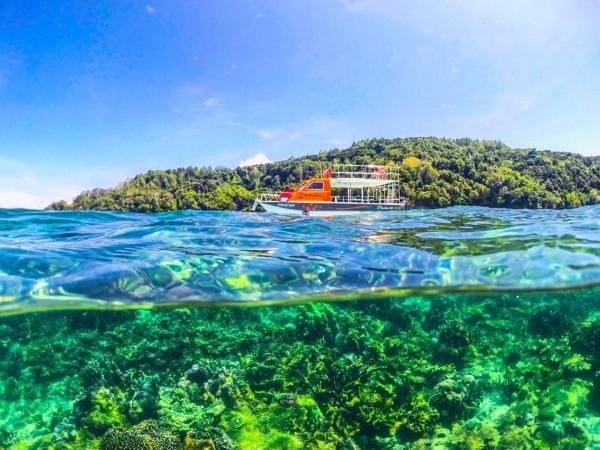
Overview of Kota Kinabalu
History & Cultural Influence
Kota Kinabalu, originally known as Jesselton, was founded in the late 19th century as a port town and trading hub for British interests in Borneo. Named after Sir Charles Jessel, its strategic location fueled its early development. During World War II, the city suffered extensive damage, but landmarks like the Atkinson Clock Tower, built in 1902, survived, symbolizing resilience through turbulent times. After the war, Kota Kinabalu rapidly rebuilt, transforming into a vibrant city and the capital of Sabah, driving urban growth and economic progress.
Kota Kinabalu boasts a vibrant cultural mosaic, home to indigenous groups like the Kadazan-Dusun, Bajau, and Murut, alongside Chinese and Malay communities. This rich ethnic diversity is reflected in the city’s lively festivals, languages, and culinary traditions. Events like the Kaamatan Festival celebrate the heritage of the Kadazan-Dusun people with traditional music, dance, and food. The city's culinary scene is a reflection of its multicultural identity, offering dishes like hinava (a traditional fish salad) and fresh seafood. For a deeper cultural experience, the Mari Mari Cultural Village offers visitors a glimpse into the traditional lifestyles and customs of Sabah’s ethnic groups. Additionally, Kota Kinabalu’s markets, such as the Filipino Market, showcase beautiful handicrafts made by local artisans, highlighting the region’s artistic heritage.
Interaction with The Locals
When visiting Kota Kinabalu, travelers can expect a warm and welcoming atmosphere, reflecting the city's rich cultural diversity. With a blend of indigenous communities like the Kadazan-Dusun and Bajau, alongside Chinese and Malay groups. Locals are known for their hospitality and openness, often eager to share their traditions, stories, and cuisine with visitors. Tourists will find it easy to communicate, as English is widely spoken, especially in popular tourist areas. While the city embraces tourism, it's important for visitors to respect local customs, particularly when visiting religious or cultural sites.
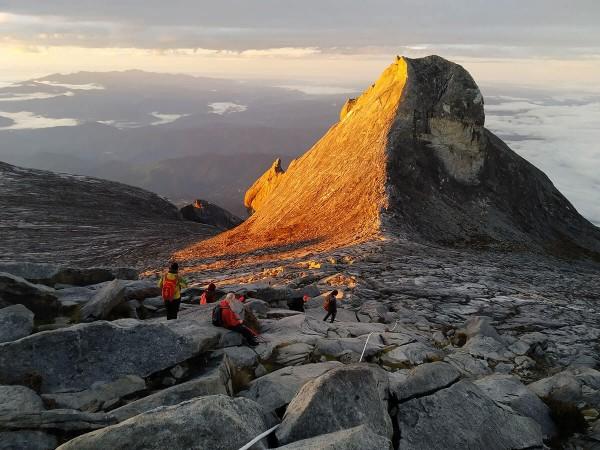
Mount Kinabalu hiking - © mountkinabalu.com
Top attractions in Kota Kinabalu
Kota Kinabalu offers stunning attractions like Mount Kinabalu, Southeast Asia's highest peak, perfect for hikers and nature lovers. Visitors can also explore the crystal-clear waters of Tunku Abdul Rahman Marine Park, ideal for snorkeling and diving, or experience the city's rich culture at the Mari Mari Cultural Village.
Mount Kinabalu
Location: West Coast Division of Sabah
Mount Kinabalu, rising 4,095 meters above sea level, is the tallest peak in Southeast Asia. Renowned for its rich biodiversity, the mountain and surrounding Kinabalu Park, a UNESCO World Heritage Site, are home to more than 4,500 plant species, including rare orchids and the world’s largest flower, the Rafflesia. Adventurous visitors can hike to the summit, while others can explore the park's lower trails, discovering its unique wildlife and plant life.
Tunku Abdul Rahman Marine Park
Location: 3 km from Kota Kinabalu
The Tunku Abdul Rahman Marine Park is made up of five picturesque islands: Gaya, Sapi, Manukan, Sulug, and Mamutik. Just a short boat ride from Kota Kinabalu, the park offers fantastic opportunities for snorkeling, diving, and exploring vibrant coral reefs teeming with marine life. Visitors can relax on the islands' pristine white sandy beaches or partake in water sports like kayaking and parasailing.
Kota Kinabalu City Mosque
Location: Jalan Pasir, Jalan Teluk Likas, Kampung Likas, Kota Kinabalu
Also known as Masjid Bandaraya, the Kota Kinabalu City Mosque is a stunning piece of Islamic architecture built on a man-made lagoon, creating a floating illusion. Its striking blue-and-gold dome and serene waterside setting make it one of the city's most iconic landmarks. At night, the mosque is beautifully illuminated, attracting visitors who come to admire its tranquility and architectural beauty.
Mari Mari Cultural Village
Location: Jalan Kionsom, Inanam, Kota Kinabalu, Sabah
The Mari Mari Cultural Village offers visitors a glimpse into the traditional lifestyles of Sabah's indigenous communities, including the Kadazan-Dusun, Bajau, Rungus, Murut, and Lundayeh. Guests can experience cultural performances, participate in blowpipe shooting, and observe traditional cooking methods. This immersive experience provides a rich understanding of the diverse heritage that defines Sabah.
Sabah State Museum
Location: Jalan Muzium, Kota Kinabalu, Sabah
The Sabah State Museum is the cultural and historical heart of the region, showcasing exhibits on the state's history, archaeology, and natural heritage. The museum features a gallery of local art, a replica of a traditional longhouse, and a botanical garden. It offers a comprehensive insight into Sabah's diverse ethnic groups, making it an educational stop for visitors interested in the region’s history and culture.
Tanjung Aru Beach
Location: Tanjung Aru Beach Resort, Tanjung Aru, Kota Kinabalu, Sabah
Tanjung Aru Beach is famous for its breathtaking sunsets, where the sky is painted in shades of orange and pink. The beach is a popular spot for locals and tourists alike, offering a relaxed setting with beachfront restaurants and cafes. Visitors can take a leisurely stroll along the shore, enjoy the sea breeze, or savor fresh seafood at one of the nearby eateries.
Signal Hill Observatory Tower
Location: 78, Jalan Asrama, signal hills, Kota Kinabalu
Perched atop Signal Hill, the Signal Hill Observatory Tower offers panoramic views of Kota Kinabalu, the surrounding islands, and the vast South China Sea. It's a favorite spot for tourists looking to capture stunning photographs of the cityscape, especially during sunset. The peaceful atmosphere and sweeping views make it a must-visit for anyone looking to appreciate the natural beauty of the area.
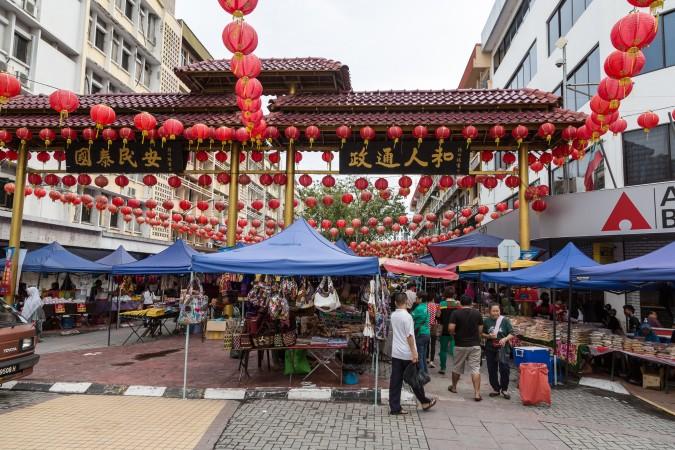
Gaya Street, Kota Kinabalu - © CEphoto Uwe Aranas
Must-Try Dishes in Kota Kinabalu
Tuaran Noodles
Tuaran Noodles are a must-try when in Sabah. These springy, thin egg noodles are stir-fried to perfection and often served with a rich broth, topped with a mix of vegetables, meat, or seafood. Originating from the town of Tuaran, the dish is loved for its unique texture and the smoky “wok hei” flavor that comes from the high-heat cooking technique. It’s a true reflection of Sabah’s emphasis on fresh, handmade ingredients and is a favorite among both locals and visitors.
Hinava
Hinava is a traditional Kadazan-Dusun dish that’s all about fresh flavors. It’s made from raw fish marinated in lime juice, mixed with shallots, chili, and ginger, and served cold. Light, tangy, and packed with a little kick from the chili, it’s often enjoyed as a refreshing appetizer. Hinava gives you a taste of the Kadazan-Dusun culture and is a perfect dish for those wanting a healthy, authentic Sabahan experience.
Sang Nyuk Min
If you’re a fan of hearty noodle dishes, Sang Nyuk Min is one to add to your list. This dish features homemade noodles served in a rich pork broth, topped with slices of tender pork, pork balls, and fresh vegetables. It’s especially popular in Sabah and showcases the locals' love for pork-based meals. Sang Nyuk Min’s flavorful broth and fresh ingredients make it a comforting, satisfying meal that captures the essence of Sabahan cuisine.
Seafood at Welcome Seafood Restaurant
For seafood lovers, dining at Welcome Seafood Restaurant in Kota Kinabalu is an unforgettable experience. The restaurant is famous for serving the freshest seafood, including fish, prawns, crabs, and shellfish, prepared in various styles—steamed, fried, or grilled to your preference. Thanks to Kota Kinabalu’s coastal location, the seafood here is as fresh as it gets, offering diners a true taste of Sabah’s rich maritime bounty.
Cinnamon Pancake (Ham Xin Piang)
Ham Xin Piang, a local favorite, is a simple yet delicious snack that you’ll often find at morning markets. It’s a pancake with a crispy exterior and a soft interior, filled with a sweet cinnamon and sugar mixture. This comforting breakfast item is beloved for its unique blend of flavors and textures, making it the perfect treat for those with a sweet tooth.
Butod (Sago Worms)
If you’re feeling adventurous, Butod (sago worms) is a delicacy you won’t want to miss in Sabah. These edible worms are traditionally eaten either raw or cooked, with deep-fried being a popular preparation. Eating Butod is more than just a culinary adventure; it’s a way to experience the indigenous food culture of Sabah. It’s a dish that highlights the local practice of using natural resources and offers a true taste of the region’s diverse and unique culinary heritage.
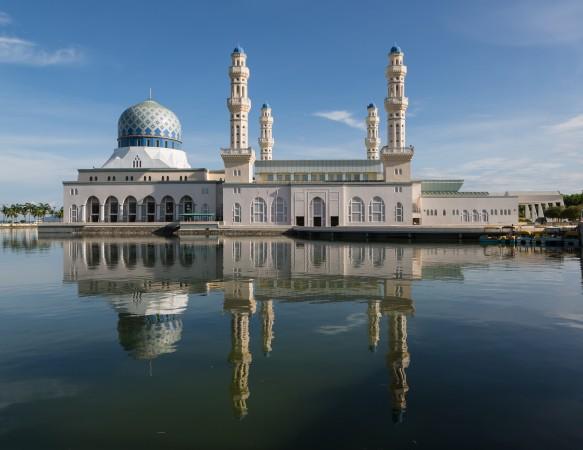
Kota Kinabalu City Mosque - © gather
Festivals & Local Celebrations
Kaamatan Festival (Harvest Festival)
Time of Year: May 30-31
The Kaamatan Festival is a vibrant celebration by the Kadazan-Dusun community to mark the rice harvest. It features lively cultural performances, traditional music, and dance, along with exciting competitions like the Unduk Ngadau (Harvest Queen) pageant. The festival also offers a variety of local food stalls, providing a chance to savor traditional dishes and fully experience Sabah’s rich cultural heritage.
Kota Kinabalu Music and Dance Festival
Time of Year: Typically held in July
This annual festival highlights both local and international musical talent with captivating performances and competitions. Attendees can enjoy diverse music genres, dance shows, and interactive workshops. The event fosters cultural exchange and artistic expression, often incorporating community involvement and charity initiatives.
Gaya Street Sunday Market
Time of Year: Every Sunday
The Gaya Street Sunday Market is a bustling weekly event where locals and tourists gather to explore stalls filled with handicrafts, fresh produce, local snacks, and souvenirs. The lively market is enhanced by street performers and food vendors, creating a festive atmosphere perfect for immersing in the local culture and cuisine.
Chinese New Year
Time of Year: January/February (date varies)
Chinese New Year is celebrated with enthusiasm in Kota Kinabalu, featuring colorful parades, lively lion dances, and impressive fireworks. The city is adorned with festive decorations, and many local restaurants offer special menus, making it a fantastic time to experience the vibrant atmosphere and cultural traditions of the Chinese community.
Hari Raya Aidilfitri
Time of Year: Varies (based on the Islamic lunar calendar)
Hari Raya Aidilfitri marks the end of Ramadan and is a major celebration for the Muslim community in Kota Kinabalu. Locals open their homes to friends and family, offering traditional dishes in a welcoming atmosphere. The city is decorated vibrantly, with prayers at mosques and community gatherings that give visitors a glimpse into local customs and hospitality.
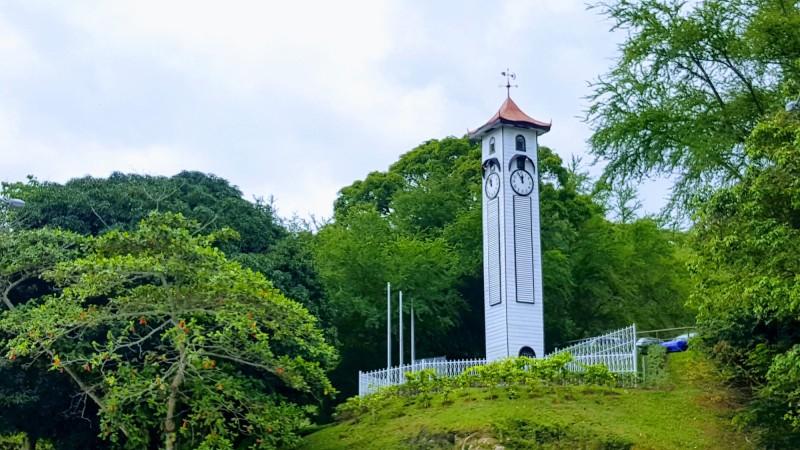
Atkinson Clock Tower - © infoGlobe
Weather in Kota Kinabalu: Best Time to Visit
Kota Kinabalu, has a tropical monsoon climate characterized by high temperatures, significant rainfall, and high humidity throughout the year.
Average Temperatures
Year-round temperatures in Kota Kinabalu generally range from 24°C (75°F) at night to about 32°C (90°F) during the day. April and May are typically the warmest months, while January is the coolest, with average lows around 23°C (73°F).
Rainfall
Kota Kinabalu experiences significant rainfall, averaging around 2,500 mm (98 inches) annually. The wettest months are usually October, November, and December, when the Northeast Monsoon brings monthly rainfall of over 300 mm (12 inches).
Best Time to Travel
The best time to visit Kota Kinabalu is between January and March when the weather is drier and more comfortable for outdoor activities. This period is also the peak tourist season. If you’re interested in local culture, visiting in May offers the opportunity to experience the Kaamatan Festival, a lively celebration of the rice harvest.
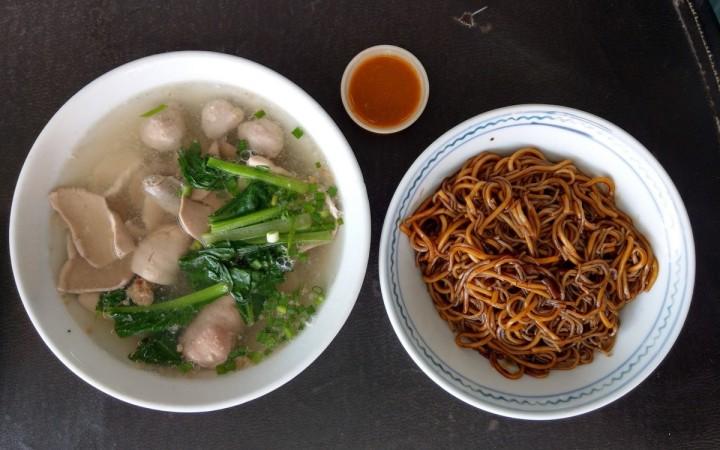
Sang Nyuk Min - © gather
Culture Etiquette in Kota Kinabalu
Dress Code
While Kota Kinabalu is more relaxed compared to other parts of Malaysia, modest attire is still recommended, especially when visiting religious sites like mosques. Women should ensure their shoulders and knees are covered, while men should avoid wearing shorts in these settings to show respect.
Greetings
Locals in Kota Kinabalu are friendly and welcoming, and a polite greeting with a smile goes a long way. Handshakes are common, but it’s courteous to wait for the other person to initiate, particularly with women, as some may prefer not to shake hands. Using appropriate titles like "Mr." or "Ms." in formal settings is appreciated.
Dining Etiquette
In some traditional eateries, particularly Malay and Indian restaurants, eating with your right hand is customary, as the left hand is considered unclean. Many places provide sinks for washing hands before and after meals. It's also worth noting that cash is often preferred in local food stalls and restaurants, so carrying enough cash is advisable.
Respect for Traditions
Kota Kinabalu is home to diverse religious communities, so it's important to respect local customs, especially during religious observances like Ramadan, when it's polite to avoid eating or drinking in public during fasting hours. Engaging in local celebrations, such as the Kaamatan Festival or Chinese New Year, is a great way to experience the culture, but always be mindful of the customs tied to these events.
Photography Etiquette
When taking photos of locals, especially in rural areas or during religious ceremonies, it’s polite to ask for permission first. Some individuals may prefer not to be photographed. Additionally, when visiting sacred spaces, be mindful of photography restrictions and dress modestly to show respect.
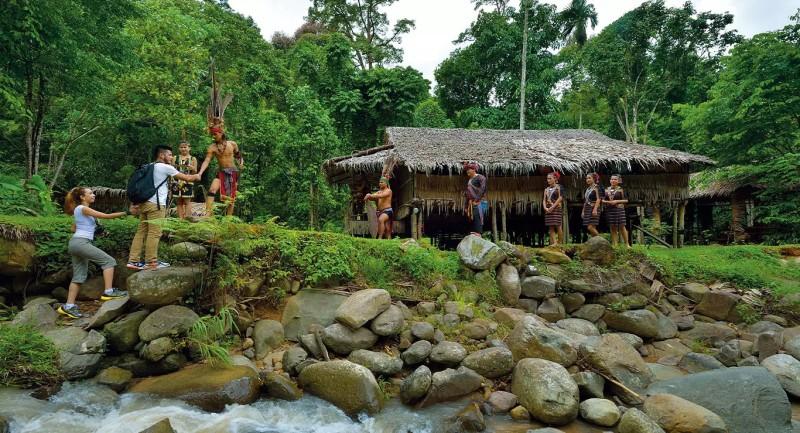
Mari Mari Cultural Village - © vima.co.id
Essential Travel Information
Getting to Kota Kinabalu
Airport Transfers
Kota Kinabalu International Airport (BKI) is conveniently located just a few kilometers south of the city center, offering a variety of transfer options to suit your needs. You can choose from private cars, shared shuttles, or taxis, with prices depending on the service type and number of passengers.
- Klook offers private car, taxi, and limousine services starting from just US$18.15 for a small group of up to three passengers.
- Jayride allows you to compare and book reliable airport shuttles or private transfers at fixed prices, with instant booking confirmation.
- Sabah Travel provides private airport transfers with licensed operators. A friendly driver will greet you at the pickup location, holding a placard for easy identification.
By Bus
Intercity buses are a popular and affordable way to travel to Kota Kinabalu from other regions in Malaysia.
- The Tun Razak Road Terminal manages city routes, while the North Kota Kinabalu Bus Terminal connects to destinations like Ranau, Semporna, Sandakan, and Tawau.
- Additional intercity connections are available at the KK Central Terminal.
Getting Around Kota Kinabalu
Public Transportation
Buses are the primary form of public transportation within the city, operating on a regular schedule.
- Hourly airport buses start at 8:00 AM, making stops at Center Point and Horizon Hotel before terminating at Merdeka Square in the city center.
- Minibuses are another option, stopping along the main road away from the airport and ending at the southern edge of the city, where you can transfer to other transportation options to reach central Kota Kinabalu.
Taxis
Taxis are widely available, but it’s a good idea to negotiate the fare in advance to avoid overcharging. For convenience, you can pre-book an airport taxi online, which provides door-to-door service. These bookings also include flight monitoring, so your pickup time will be adjusted in case of delays.
Other Transportation Options
- The city is connected to the only railway system in East Malaysia, operated by Sabah State Railways, with regular trains running to Tanjung Aru and Tenom, making several stops along the way.
- For a more leisurely experience, take a colonial steam train from Kota Kinabalu to Papar.
- If you're in the mood for a scenic island adventure, speedboats offer flexible travel options, allowing you to explore nearby islands at your own pace.
ATM and Banking Services
Kota Kinabalu provides a variety of banking services and numerous ATMs, making it easy for both locals and visitors to access cash. ATMs from major banks such as CIMB, Maybank, HSBC, and Public Bank are conveniently located throughout the city.
- CIMB Bank: Located at Km 4, Tanjung Aru, offering various banking services, including ATM access.
- HSBC: Situated at 56 Jalan Gaya, providing 24-hour ATM services along with a full range of banking options.
- Public Bank: ATMs are available at key locations like Jalan Pantai, known for their reliable service.
- Alliance Bank: Found in the Mini Sports Complex Building, offering banking services and ATMs.
For currency exchange, services are available at banks, hotels, and dedicated exchange counters. It's best to use reputable providers to ensure competitive rates.
Accommodation Choices
Kota Kinabalu boasts a wide selection of accommodations to cater to different budgets and travel preferences, ranging from luxury resorts to budget-friendly stays.
Luxury Hotels
- Shangri-La's Tanjung Aru Resort & Spa: A luxurious resort offering breathtaking views of the South China Sea, along with a spa, multiple dining options, and extensive amenities.
- Le Meridien Kota Kinabalu: Located on the waterfront, this hotel features modern rooms and easy access to shopping and dining areas.
Mid-Range Hotels
- Hotel Jen Kota Kinabalu: A contemporary hotel with comfortable rooms, a rooftop pool, and proximity to local attractions.
- The Pacific Sutera Hotel: Featuring a range of amenities, including golf courses and a marina, perfect for both leisure and business travelers.
Budget Accommodations
- Borneo Backpackers: A favorite for budget travelers, offering dormitory-style rooms and a friendly, laid-back atmosphere.
- The Jesselton Hotel: A charming heritage hotel that provides affordable accommodations with a touch of local history.
Serviced Apartments
- G Hotel Kota Kinabalu: Ideal for longer stays or families, offering serviced apartments with hotel-like amenities for added comfort.
Articles for you

Explore Yala National Park - Sri Lanka Travel, Asia
Tucked away in Sri Lanka’s southeastern corner, Yala National Park is where wild nature meets deep tradition. Known worldwide for its leopard population, the park is also home to elephants, sloth bears, crocodiles, and hundreds of bird species. Beyond wildlife, Yala opens doors to a cultural landscape dotted with ancient temples, Buddhist ruins, and coastal villages. For travelers seeking more than just a safari, Yala offers a chance to explore eco-tourism, local communities, and sacred heritage sites.
Population: The Yala National Park area doesn’t have a human population.
Economy: The economy around Yala National Park thrives on a blend of eco-tourism, agriculture, and local services. Safari tours, eco-lodges, and cultural experiences drive steady income for nearby towns like Tissamaharama and Kataragama, supporting thousands of families.
Landmarks: Famous for Block I of Yala and wildlife encounters, including elephants, sloth bears, crocodiles, and exotic bird species.

Explore Galle - Sri Lanka Travel, Asia
Nestled on Sri Lanka’s southern coastline, Galle is a vibrant city where history meets the sea. Its cobbled streets, colonial architecture, and serene beaches make it a must-visit destination for travelers seeking a blend of culture, adventure, and relaxation. A UNESCO World Heritage site, Galle captivates visitors with its Dutch Fort, bustling markets, and friendly locals. Whether you’re exploring the ramparts at sunset or savoring fresh seafood by the shore, Galle promises an unforgettable journey into Sri Lanka’s heritage.
Population: Approximately 113,000 in 2023.
Economy: Galle’s economy thrives on tourism, trade, and fisheries. The city’s historic fort, colonial architecture, and coastal charm draw thousands of international visitors each year, making tourism its main economic driver. Fishing remains vital for local livelihoods, supplying fresh seafood across the region.
Landmarks: Famous for the Galle Fort, Dutch Reformed Church & Maritime Museum, and Unawatuna Beach.

Explore Bentota - Sri Lanka Travel, Asia
Nestled along Sri Lanka’s southwestern coast, Bentota is a tropical paradise that blends golden beaches, vibrant culture, and thrilling adventures. Famous for its calm waters, luxury resorts, and scenic river estuary, Bentota has become a top destination for travelers seeking both relaxation and authentic experiences. From serene beach walks at sunrise to adrenaline-pumping water sports, this coastal town offers a perfect balance of leisure and exploration. With its proximity to Colombo and Galle, Bentota is easy to reach, making it an ideal stop for both short escapes and extended holidays.
Population: Approximately 37,000 in 2023.
Economy: Bentota’s economy thrives mainly on tourism, which drives local businesses such as hotels, restaurants, and wellness retreats. The town also benefits from fishing, coconut cultivation, and handicrafts like wood carving and batik textiles. Many residents rely on the growing demand for water sports and Ayurvedic treatments, making tourism the backbone of both income and employment in the area.
Landmarks: Famous for Bentota Beach, Bentota River Safari, and Kande Vihara Temple.

Explore Mirissa - Sri Lanka Travel, Asia
Mirissa is a charming coastal town on Sri Lanka’s southern shoreline. Known for its golden beaches, turquoise waters, and vibrant marine life, it has become a must-visit stop for travelers exploring the island. Many come for whale watching, surfing, and sunset views at Coconut Tree Hill, but Mirissa offers much more than postcard beauty. The fishing boats you see anchored by the bay carry generations of stories. Local traditions, delicious cuisine, and a laid-back rhythm of life shape every visitor’s experience.
Population: Approximately 4,700 in 2023.
Economy: Mirissa’s economy is largely shaped by its coastal location. Fishing has long been the backbone of local livelihoods, with generations relying on the Indian Ocean for income. In recent decades, tourism has become the main driver of growth, thanks to whale watching, surfing, and beachside hospitality.
Landmarks: Famous for Mirissa Beach, Coconut Tree Hill, and Parrot Rock Bridge.

Explore Nuwara Eliya - Sri Lanka Travel, Asia
Tucked away in the Central Highlands of Sri Lanka, Nuwara Eliya is often called “Little England”. With its rolling tea plantations, cool misty mornings, and colonial charm, this mountain town feels like a step into another world. Travelers come here to breathe fresh air, walk through flower gardens, sip the finest Ceylon Tea, and enjoy a pace of life far from the island’s busy cities. Whether you’re drawn by scenic landscapes, heritage architecture, or the warmth of its people, Nuwara Eliya is a destination that blends nature, culture, and history in perfect harmony.
Population: Approximately 781,000 in 2023.
Economy: Nuwara Eliya’s economy thrives mainly on tea production, as it sits in the heart of Sri Lanka’s central highlands, famous worldwide for Ceylon Tea. The city also benefits from a growing tourism industry, attracting visitors with its colonial charm, cool climate, and scenic landscapes.
Landmarks: Famous for Gregory Lake, Hakgala Botanical Garden, and Victoria Park.

Explore Sukau - Malaysia Travel, Asia
Nestled on the banks of the Kinabatangan River in Sabah, Malaysian Borneo, Sukau is a destination where wildlife, culture, and conservation come together. Known as one of Asia’s top spots for river safaris and eco-tourism, this quiet village offers a front-row seat to encounters with Bornean orangutans, pygmy elephants, proboscis monkeys, and exotic birdlife.
Population: Approximately 1,400 in 2019.
Economy: Sukau’s economy is shaped by its riverine location and natural resources. Traditionally, the Orang Sungai community relied on fishing, small-scale farming, and forest gathering for their livelihood. Today, the village has shifted toward eco-tourism, with river cruises, jungle trekking, and homestays providing income.
Landmarks: Famous for the Kinabatangan River cruises, Gomantong Caves, and Ox-bow lakes and wetlands.
